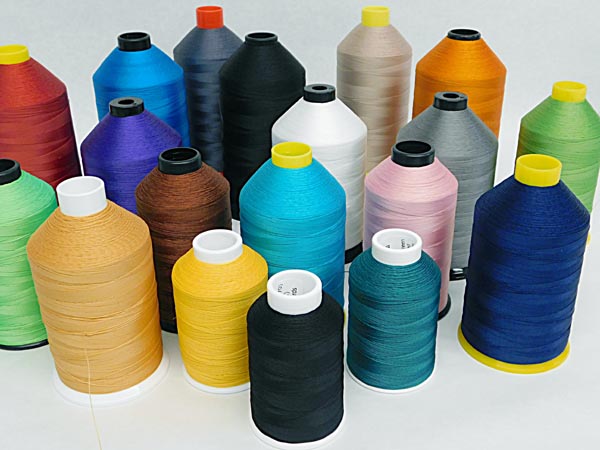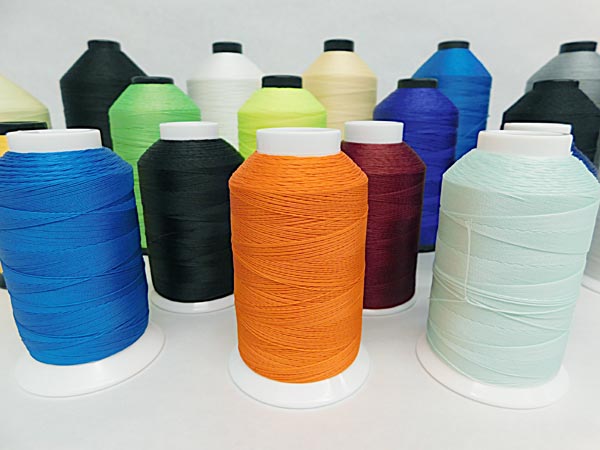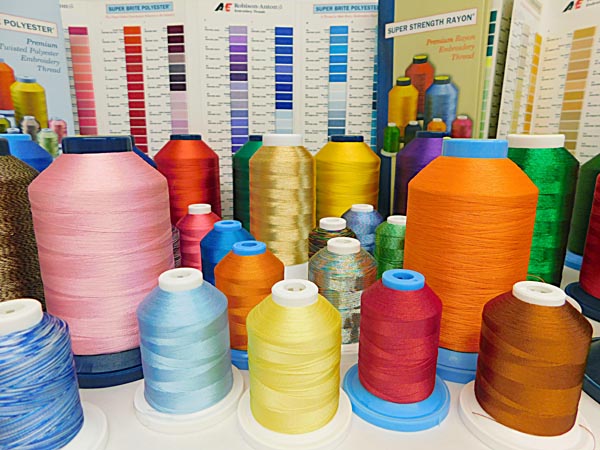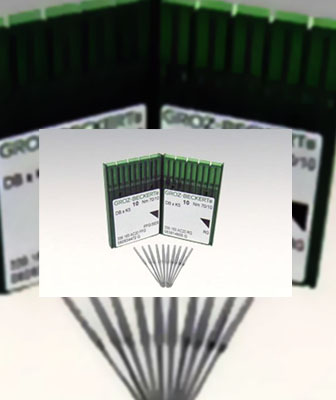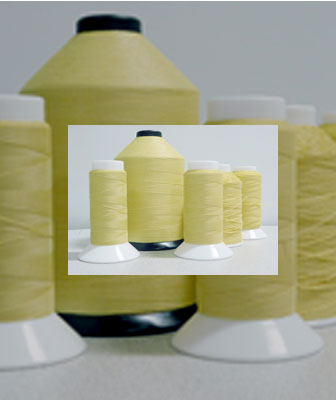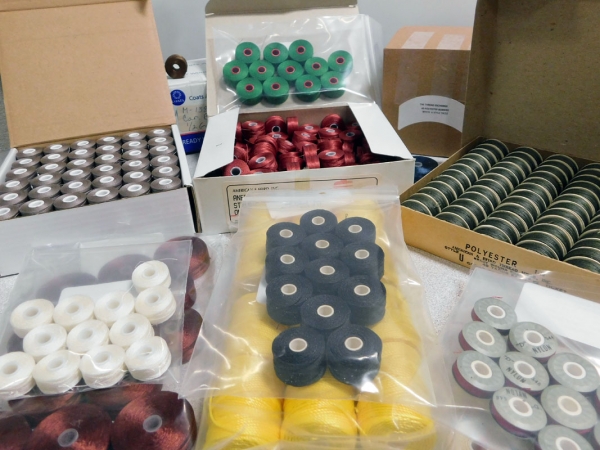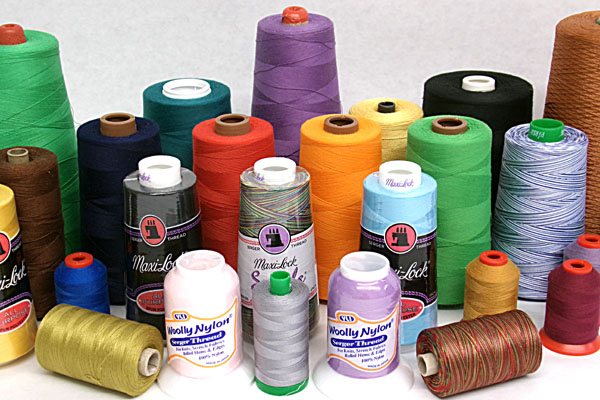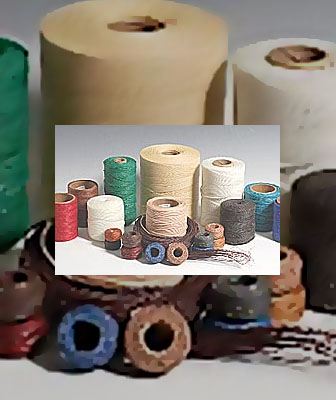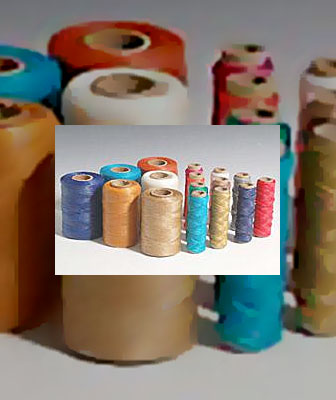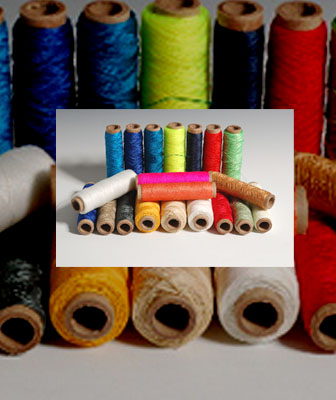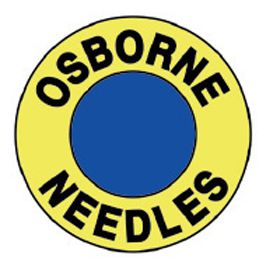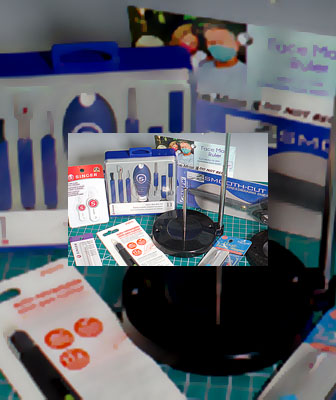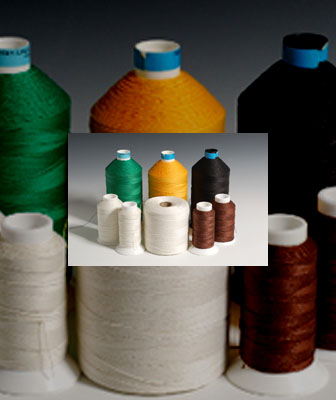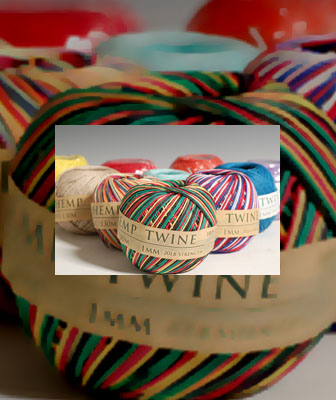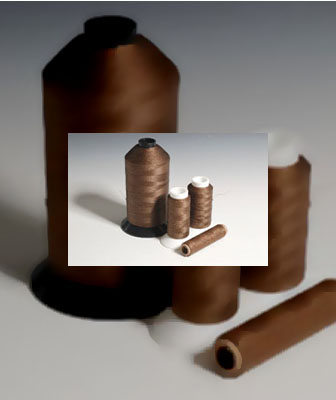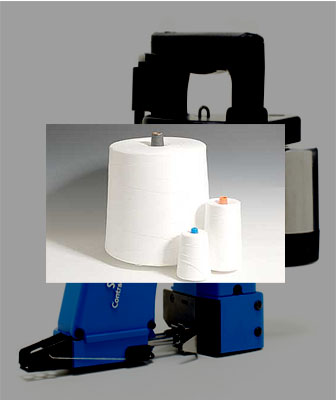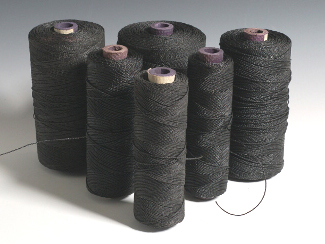Nylon Thread Guide

Nylon Thread Buying Guide
The Nylon Thread Buying Guide helps customers get the right thread for their needs. Our approach is to decide if nylon is the right thread for the job, identify which sizes (thicknesses) should be used, and finally pick the color and spool size that works. We have nylon thread in eleven sizes, over 100 colors, and putups ranging from small spools priced around $13 to discounted cases.
Information Topics
Selecting Nylon Thread
- Nylon Thread Glossary - The nylon thread glossary covers common terms used when shopping for nylon thread.
- Nylon Thread Uses - Where using nylon thread works best.
Nylon Thread Properties
- Normal Wear and Tear - Topics cover elongation over time, mildew, aging, UV, abrasion, and heat resistance.
- Nylon Thread Limitations - Conditions where using another type of thread may be better suited.
Nylon Thread Sizing
- Overview - Considerations for selecting the right size nylon thread.
- Size Descriptions - Use the nylon by size description chart to determine machine capability, stitch visibility, and needle to thread size.
- Nylon Thread Size Specifications - Covers equivalent size standards, strengths, thicknesses, and yards per pound.
- Thread Size to Material - Recommended thread sizes for fabric and leather.
Nylon Thread Spool Sizes
- Nominal Spool Weights - Covers maximum and minimum allowances for thread per spool.
- Spool Dimensions - Covers spool sizes, and options for using larger spools.
Selecting Nylon Thread
With nylon thread selection, understanding terminology, uses, limitations, and sizes are some of the most important considerations in order to ensure the best choice possible.
Nylon Thread Glossary
Bonded - Bonded nylon has a protective coating on the thread to resist against fraying, needle friction and heat when it is sewn at higher speeds. Bonding also helps to prevent unraveling. It is important to note that colors of bonded threads appear slightly darker on the spool. Colors will become lighter when sewn.
Other types of bonded thread we carry
-
Nomex Thread - Limited Stock - Special ordering available.
Soft - A nylon thread that is not bonded. It is suitable for sewing at slower speeds. It is better suited for gluing applications, because bonded coatings repel glues and adhesives.
Left Twist - The standard ply twist direction for almost every single-needle machine on the market. It is widely known as a Z-Twist, or Standard Twist. All of our thread is left twist unless otherwise noted.
Right Twist - This is widely known an S-Twist, and sometimes a Reverse Twist. It is more commonly used in double needle machines for banners. It is easier to find a right-twist polyester thread.
Size - A number designation given to a threads thickness, based on weight. We carry eleven different sizes from the ultra-thin Size 15, to the ultra-thick Size 554. The most popular size is Size 69. There are 4 main size standards: Commercial, Tex, TKT, and Government. Our product listings use commercial sizing. Our Specifications chart shows equivalent sizing.
Putup - Putup refers to the amount of thread on a spool. Commercial sewers generally buy nylon thread by the pound; hobbyists and casual sewers can save with our two and four ounce spools.
Monocord - A single ply of nylon thread that is not sensitive to machine twist direction. It is about 10 to 14% stronger. But, it is thinner than regular nylon for reduced stitch appearance. Monocord usually requires a tensioning adjustment. Once it is made, it runs very smooth. UV rated nylon is more often available in monocord.
Nylon Thread Uses
Nylon thread is a great choice for sewing fabric, leather, canvas, and vinyl. We sell nylon thread in eleven sizes that range from ultra-thin to cord-like. Our Use by Size Guide shows more details about selecting the best sizes or possibly better suited types of thread to use.
Here are some things you can do with nylon thread: Athletic Gear, Auto Upholstery, Backpacks, Collars, Corn Hole Bags, Drapes, Furniture, Handbags, Holsters, Horse Blankets, Laptop Cases, Leatherwork, Menu Covers, Orthopedics, Pet Bedding, Purses, Saddles, Sandbags, Slip Covers, Sheaths, Straps. Upholstery, Wallets, Webbing, X-Ray Aprons.
Nylon Thread Properties
Normal Wear and Tear
Elongation - Nylon thread stretches about 26% over time. This is beneficial for its end use, because it allows for the seams to stretch with the fabric, allowing for 'breaking in'. For active wear and lighter materials, Woolly Nylon thread has a greater stretch. It is categorized separate from the nylon on this page as a serger thread. Kevlar Thread has about a 2% stretch.
Mildew, Aging, and Sunlight - Nylon thread has excellent resistance to mildew and aging, but prolonged exposure to sunlight causes some deterioration. Polyester or specially treated UVR Nylon are better for long-term exposure to sunlight. If seams are not exposed, nylon is usually okay.
Abrasion - Nylon Thread has excellent abrasion resistance.
Heat - Nylon thread will begin to yellow at around 300F. Prolonged exposure to temperatures over 285F will cause deterioration. Nylon thread begins to stick at approximately 445F, and melt at around 485 to 500F.
Chemical Resistance - Bleaches and Solvents - Nylon thread can be bleached in most solutions, but it is generally insoluble in most organic solvents. It is soluble in some phenolic compounds.
Chemical Resistance - Hydrocarbons - Nylon thread has excellent resistance to hydrocarbons such as gasoline, Diesel, and kerosene.
Chemical Resistance - Acids and Alkalis - Nylon thread is unaffected by most mineral acids, except hot mineral acids. It dissolves with partial decomposition in concentrated solutions of hydrochloric, sulfuric, and nitric acids. Soluble in formic acids. Substantially inert in alkalis.
Nylon Thread Limitations
Nylon thread is popular because of its versatility, durability, and strength to size. There are applications where other types of thread may be better suited depending on the conditions the end use will be under. The most notable circumstances are:
Outdoor applications with prolonged sunlight exposure - Nylon thread can withstand moderate exposure to sunlight, provided that it is not exposed long term, or there is some sort of ultraviolet (UV) protection (e.g. windshields, or unexposed seams). This is why it is popular for automotive interiors, upholstery, and many other applications. It should not be used for outdoor furniture and sewing sails, awnings, tarpaulins. In these cases Polyester Thread or UVR Nylon thread are better choices. Polyester looks and feels like nylon, and has very close size-for-size strength. Its pricing is comparable to nylon.
Fire retardant garments and gear - Nylon thread yellows at 300F, sticks at 445F and melts at 500F. First responder garments and gear and some high temperature conveyer belts require much more fire resistance. Use Kevlar or Fire Retardant Sewing Thread in these situations. They are heat resistant to 600F or more and do not melt. However, they do not do well with UV. Their pricing is much higher than nylon.
Critical strength requirements - Nylon is strong but Kevlar Thread is about twice as strong. For example, size 92 nylon has a 15 pound tensile strength; the same size Kevlar has a 30 pound tensile strength. Kevlar's downside is that it costs about five times more than nylon and only available in yellow. Consider using heavier weight nylon or double-stitching to meet strength requirements.
Cotton-like look - Our nylon thread has a smooth, glossy, shiny finish that does not go well with garments that need a soft, fuzzy, cotton-like look. In these cases, Cotton, Spun Polyester, and Wooly Nylon are better and less expensive choices.
Clear, or Invisible Stitching - Related Category: Monofilament Thread. Monofilament is also made from nylon. Its construction is similar to fishing line, and is categorized separately.
Chemical Resistance - Nylon does well with some chemicals and not as well with others. Nylon thread can be bleached in most solutions, but it is generally insoluble in most organic solvents. It is soluble in some phenolic compounds.
Nylon Thread Sizing
Overview
Thread size is important because there are many considerations. The main ones are:
- Machine Capability - Home, commercial and heavy duty sewing machines have different thread and needle size limitations.
- Needle Size - Needles have sizes that are best suited for specific thread sizes and machine types.
- Stitch Appearance - Are you looking for stitching to be inconspicuous, noticeable, very noticeable, or to be a focal point?
- Strength - Is the thread a suitable strength for what is being sewn?
When nylon thread's size increases...
- Commercial and Tex Equivalent numbers increase.
- Machine capability requirements increase.
- Thread diameter increases.
- Thread strength increases.
- Needle size increases.
- Needle heat and friction increase.
- Stitch visibility increases.
- Fabric ounce per yard increases.
- Leather ounce per yard increases.
- Yards per pound decreases.
Nylon Thread Size Descriptions
Use the nylon by size description chart to determine machine capability. Home, commercial and heavy duty sewing machines have different thread and needle size limitations. This chart also describes in general way, the level of stitch visibility, and notes that are relevant to size.
Nylon - Size 15
Size 15 (Tex 16) nylon is an ultra lightweight thread used on home and commercial machines with a size 70/10 to 80/12 needle. Its stitch appearance is inconspicuous. All size 15 items are soft, and on clearance. Alternatives may be available in Polyester Thread, Cotton and Spun Polyester.
Nylon - Size 33
Size 33 (Tex 30) nylon is a lightweight thread used on home and commercial machines with a size 80/12 to 90/14 needle. Its stitch appearance is inconspicuous. Size 33 nylon has increased in popularity in recent years, and we now carry it in basic colors.
Nylon - Size 46
Size 46 (Tex 45) nylon is a lightweight thread used on home and commercial machines with a size 90/14 to 100/16 needle. Its stitch appearance is inconspicuous. It is available in about 90 colors.
Nylon - Size 69
Size 69 (Tex 70) is a middleweight thread used on home and commercial machines with a size 100/16 to 110 /18 needle. Its stitch appearance is inconspicuous, becoming more noticeable. It is our most popular size. It is the thickest size most home sewing machines can handle, and it is available in over 160 colors.
Nylon - Size 92
Size 92 (Tex 90) is a middleweight thread used on commercial machines with a size 110/18 to 125/20 needle. Its stitch appearance is noticeable. Most people cannot break a size 92 nylon by hand. It is available in about 80 colors.
Nylon - Size 138
Size 138 (Tex 135) is a middle to heavyweight thread used on commercial and heavy duty machines with a size 125/20 to 140/22 needle. Its stitch appearance is noticeable, beginning to stand out. It is our second most popular size, and it is available in over 120 colors.
Nylon - Size 207
Size 207 (Tex 210) is a heavyweight thread used on commercial and heavy duty machines with a size 140/22 to 180/24 needle. Its stitch appearance stands out. It is available in mostly basic colors.
Nylon - Size 277
Size 277 (Tex 270) is a heavyweight thread used on commercial and heavy duty machines with a size 180/24 to 220/26 needle. Its stitch appearance stands out, becoming more of a focal point. It is available in very basic colors.
Nylon - Size 346
Size 346 (Tex 350) is a heavyweight thread used on heavy duty machines with a size 220/26 to 260/28 needle. Its stitch appearance is a focal point. It is available in black, white, brown, and in some closeout colors.
Nylon - Size 415
Size 415 (Tex 410) is a heavyweight thread used on heavy duty machines with a size 260/28 to 330/30 needle. Its stitch appearance is a focal point. It is available in black, white, and in some closeout colors.
Nylon - Size 554
Size 554 (Tex 600) is an ultra heavyweight thread used on heavy duty machines with a size 330/30 to 360/32 needle. Its stitch appearance is a focal point. It is available in black and white, and is about 1 mm thick.
Nylon Thread Size Specifications
Commercial sizing is most widely used thread size standard. Our nylon thread shopping selections are listed in commercial sizes. Occasionally we have some off sizes. When this happens, we use the closest Tex Equivalent to the commercial size. Government sizes fall under Military Specification A-A-59826 (Formerly VT-295E). We also have more information about yards per spool under related topic: Spool Sizes.
Nylon - Size 15
-
Commercial Size 15, Tex 16 (T-16), Gov't Size 00
-
Average Strength 2.0 Lbs. (0.9 kg)
-
Average Thickness 6/1000" (0.006 in.), or 0.10 mm
-
Recommended Needle Sizes 70/10 to 80/12
-
Average Yards 1750 per ounce (28,000 per Pound)
Nylon - Size 33
- Commercial Size 33, Tex 30 to 35 (T-30 to T-35), Gov't Size AA, Tkt 80
- Average Strength 5.0 Lbs. (2.3 kg)
- Average Thickness 8/1000" (0.008 in.), or 0.20 mm
- Recommended Needle Sizes 80/12 to 90/14
- Average Yards 850 per ounce (13,800 per Pound)
Nylon - Size 46
- Commercial Size 46, Tex 45 (T-45), Gov't Size B, Tkt 60
- Average Strength 8.0 Lbs. (3.6 kg)
- Average Thickness 9/1000" (0.009 in.), or 0.24 mm
- Recommended Needle Sizes 90/14 to 100/16
- Average Yards 625 per ounce (10,000 per Pound)
Nylon - Size 69
- Commercial Size 69, Tex 70 (T-70), Gov't Size E, Tkt 40
- Average Strength 11.0 Lbs. (5.0 kg)
- Average Thickness 12/1000" (0.012 in.), or 0.29 mm
- Recommended Needle Sizes 100/16 to 110 /18
- Average Yards 375 per ounce (6,000 per Pound)
Nylon - Size 92
- Commercial Size 92, Tex 90 (T-90), Gov't Size F, Tkt 30
- Average Strength 15.0 Lbs. (6.8 kg)
- Average Thickness 13/1000" (0.013 in.), or 0.34 mm
- Recommended Needle Sizes 110/18 to 125/20
- Average Yards 263 per ounce (4,200 per Pound)
Nylon - Size 138
- Commercial Size 138, Tex 135 (T-135), Gov't Size FF, Tkt 20
- Average Strength 22.0 Lbs. (10.0 kg)
- Average Thickness 16/1000" (0.016 in.), or 0.41 mm
- Recommended Needle Sizes 125/20 to 140/22
- Average Yards 187 per ounce (3,000 per Pound)
Nylon - Size 207
- Commercial Size 207, Tex 210 (T-210), Gov't Size 3 Cord, Tkt 15
- Average Strength 32.0 Lbs. (14.5 kg)
- Average Thickness 20/1000" (0.020 in.), or 0.51 mm
- Recommended Needle Sizes 140/22 to 180/24
- Average Yards 125 per ounce (2,000 per Pound)
Nylon - Size 277
- Commercial Size 277, Tex 270 (T-270), Gov't Size 4 Cord, Tkt 10
- Average Strength 45.0 Lbs. (20.4 kg)
- Average Thickness 23/1000" (0.023 in.), or 0.59 mm
- Recommended Needle Sizes 180/24 to 220/26
- Average Yards 93 per ounce (1,496 per Pound)
Nylon - Size 346
- Commercial Size 346, Tex 350 (T-350), Gov't Size 5 Cord
- Average Strength 53.0 Lbs. (24.0 kg)
- Average Thickness 26/1000" (0.026 in.), or 0.66 mm
- Recommended Needle Sizes 220/26 to 260/28
- Average Yards 75 per ounce (1,200per Pound)
Nylon - Size 415
- Commercial Size 415, Tex 410 (T-410), Gov't Size 6 Cord
- Average Strength 73.0 Lbs. (32.7 kg)
- Average Thickness 28/1000" (0.028 in.), or 0.72 mm
- Recommended Needle Sizes 260/28 to 330/30
- Average Yards 65 per ounce (1,040 per Pound)
Nylon - Size 554
- Commercial Size 554, Tex 600 (T-600), Gov't Size 8 Cord
- Average Strength 83.0 Lbs. (37.7 kg)
- Average Thickness 40/1000" (0.040 in.), or 1.02 mm
- Recommended Needle Sizes 330/30 to 360/32
- Average Yards 41 per ounce (656 per Pound)
Thread Size to Material
The material that you are sewing costs far more than the thread. In most cases, with the exception of parachutes, it is better for the thread to break than to have the stitches pull through the fabric. This means that the weight of the fabric, in ounces per square yard, is the best way to determine thread size. Here are size recommendations for fabric and leather.
Fabric Ounce to Yard and Thread Size Range
2 to 6 Ounce Fabric: Nylon Thread Sizes 15 to 33
6 to 8 Ounce Fabric: Nylon Thread Sizes 33 to 46
8 to 10 Ounce Fabric: Nylon Thread Sizes 69 to 92
12 to 14 Ounce Fabric: Nylon Thread Sizes 92 to 207
Comments
There other things to consider. You may use a thinner thread because your machine cannot handle a heavier thread, if it does not compromise safety. Or, you may choose a thicker thread because you want stitches to stand out. Selecting specific needle points designed for specific materials is recommended if a universal, round point needle won't suffice.
Leather Ounce to Yard and Thread Size Range
2 to 3 Ounce Leather: Nylon Thread Sizes 33 to 69
3 to 4 Ounce Leather: Nylon Thread Sizes 46 to 92
4 to 5 Ounce Leather: Nylon Thread Sizes 69 to 138
5 to 6 Ounce Leather: Nylon Thread Sizes 92 to 207
7 to 8 Ounce Leather: Nylon Thread Sizes 138 to 277
8 to 9 Ounce Leather: Nylon Thread Sizes 207 to 554
Multiple Layers of Leather: Nylon Thread Sizes 207 to 554
Comments
There other things to consider. You may use a thinner thread because your machine cannot handle a heavier thread, if it does not compromise safety. Or, you may choose a thicker thread because you want stitches to stand out.
Nylon Thread Spool Sizes
We sell most of our nylon thread in 4 and 16 Ounce (1 Pound) spool sizes or putups. The smaller putups cost more per ounce than the larger ones. But, they are a better choice for one-time jobs, casual sewing, people who need a stash of many colors, and experimenters. Nylon thread is sold by weight (ounces, pounds) - not yards. This is because the number of yards-per-pound decreases as thread thickness increases. Selling by weight means prices for a given size spool are about the same across most thread sizes.
Industry norms allow nylon thread spool weights to vary by plus/minus 10% from the stated nominal weight. This means that customers get slightly less or slightly more thread than the nominal weight shown on our site. This chart shows our nominal weights and the thread-weight range (including the spool's weight) for various sizes. When spools fall within these ranges, we do not charge for when they go over or refund for when they go under. It is important to note that we usually do not charge when a spool goes over the maximum tolerance, but we will always refund when they go below the tolerance.
Nominal 2 Oz Spool - Minimum Spool Weight: 2.6 Oz., Maximum Spool Weight: 4.5 Oz.
Nominal 4 Oz Spool - Minimum Spool Weight: 4.6 Oz., Maximum Spool Weight: 5.9 Oz.
Nominal 6 Oz Spool - Minimum Spool Weight: 6.0 Oz., Maximum Spool Weight: 7.9 Oz.
Nominal 8 Oz Spool - Minimum Spool Weight: 8.0 Oz., Maximum Spool Weight: 10.5 Oz.
Nominal 12 Oz Spool - Minimum Spool Weight: 10.6 Oz., Maximum Spool Weight: 15.5 Oz.
Nominal 16 Oz Spool - Minimum Spool Weight: 15.6 Oz., Maximum Spool Weight: 19.9 Oz.
Spool Dimensions
All of our nylon thread is wound on king spools unless otherwise noted. Most of our 2 and 4 ounce spools are wound in-house, and the spool sizes are consistent for those. Normally, manufacturer spool dimensions are consistent. There are some times one-off occasions where manufacturers will wind 12 and 16 ounce spools with different heights, but the base dimensions remain constant.
Average Spool Dimensions
2 and 4 Oz Spools - Base: 2.5", Height: 4.5"
6 and 8 Oz Spools - Base: 3.0", Height: 5.25"
12 and 16 Oz Spools By Brand
A&E (Anefil Nylon) - Base: 4.5", Height: 7.5"
Amann USA (Strongbond) - Base: 4.5", Height: 7.5"
Ozen (Bondylon) - Base: 4.5", Height: 6.5"
Eddington - Base: 4.5", Height: 6.5"
Fil-Tec (BNT) - Base: 4.5", Height: 7.5"
Service Thread - Base: 4.5", Height: 6.5"
Inside Diameter
The inside shaft diameter of all spools
described, regardless of base and height,
is 1 inch.
Comments
For sewing machines not geared to handle these size spools, a
Thread Cone Holder may be needed. It is designed to help machines bypass these limitations. There are also DIY thread cone holders that are can be made from PVC pipe, wire coat hangers, or coffee cups most notably. The advantage of a thread cone holder is that it is specifically designed for sewing.
We also carry 100 yard and 50 yard Hand Stitching Tubes. They are not particularly designed for machine sewing, but customers have created Do-It-Yourself adaptors.
It is important to note that DIY projects can cause machine damage or create tensioning issues if not made properly.
About Nylon Thread Sizes
-
Size 33 / Tex 30 / Govt. AA - Lightweight thread used it for sewing garments, thin leather purses and wallets. Use needle sizes 80/12 to 90/14
-
Size 46 / Tex 45 / Govt. B - Lightweight thread used for sewing lightweight tents, thin leather, outdoor garments, and delicate upholsteryUse needle sizes 90/14 to 100/16
-
Size 69 / Tex 70 / Govt. E - Our most popular size, with the widest color selection of all our sizes. It is a middleweight thread and the largest size most home sewing machines can handle. Typical uses include sewing lightweight furniture upholstery, leather, outdoor gear, garments, upholstery, drapes. Use needle sizes 100/16 to 110 /18
-
Size 92 / Tex 90 / Govt. F - Middleweight thread used for sewing upholstery, leather, auto interiors, military gear, dog collars, banners, and blankets. Usually requires a commercial machine. Use needle sizes 110/18 to 125/20
-
Size 138 / Tex 135 / Govt. FF - Middleweight thread whose stitches are noticeable. Use it for sewing upholstery, leather, auto interiors, tents, taupaulns, banners, musical instruments, covers, dog collars. Use needle sizes 125/20 to 140/22
-
Size 207 / Tex 210 / Govt. 3-Cord - Heavyweight thread whose stitches are very noticeable. Use it for sewing leather, upholstery, auto interiors, covers, and horse tack. Use needle sizes 140/22 to 180/24
-
Size 277 / Tex 270 / Govt. 4-Cord - Heavyweight thread whose stitches are highly visible. Use it for sewing saddles and tack, holsters, sheaths, belts, and heavy duty tarpaulins and covers. Requires a commercial or heavy duty machine. Use needle sizes 180/24 to 230/26
-
Size 346 / Tex 350 / Govt. 5-Cord - Heavyweight thread with stitching becoming a focal point. Used for sewing conveyor belts, heavy duty tarpaulins and covers, holsters, sheaths, belts, and shoe repair. Requires a heavy duty machine. Use needle sizes 230/26 to 260/28
-
Size 415 / Tex 410 / 6-Cord - Heavyweight whose stitches become the focal point. Use it for sewing boots and shoes, conveyor belts, heavy duty tarpaulins and covers, holsters, sheaths, belts, and hanging objects. Requires a heavy duty machine. Use needle sizes 280/28 to 330/30
-
Size 554 / Tex 600 / Govt. 8-Cord - Our heaviest nylon thread with about a 1 mm diameter. Its stitches become a focal point. Use it for sewing shoes and boots, conveyor belts, heavy duty tarpaulins and covers, holsters, sheaths, belts, and hanging objects. Use needle sizes 330/30 to 360/32
